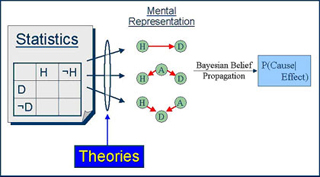
People's domain theories mediate between observed statistics and causal models generated to account for the statistics. Causal models can be used to judge the probability of a variable, given that other variables have been observed. (Image by Prof. Joshua Tenenbaum.)
Instructor(s)
Prof. Joshua Tenenbaum
MIT Course Number
9.916-A
As Taught In
Spring 2003
Level
Undergraduate / Graduate
Translated Versions
Course Description
Course Description
Probability theory captures a number of essential characteristics of human cognition, including aspects of perception, reasoning, belief revision, and learning. Expressions of degree of belief were used in language long before people began codifying the laws of probability theory. This course explores the history and debates over codifying the laws of probability, how probability theory applies to specific cognitive processes, how it relates to the human understanding of causality, and how new computational approaches to causal modeling provide a framework for understanding human probabilistic reasoning.
This class is suitable for advanced undergraduates or graduate students specializing in cognitive science, artificial intelligence, and related fields.


